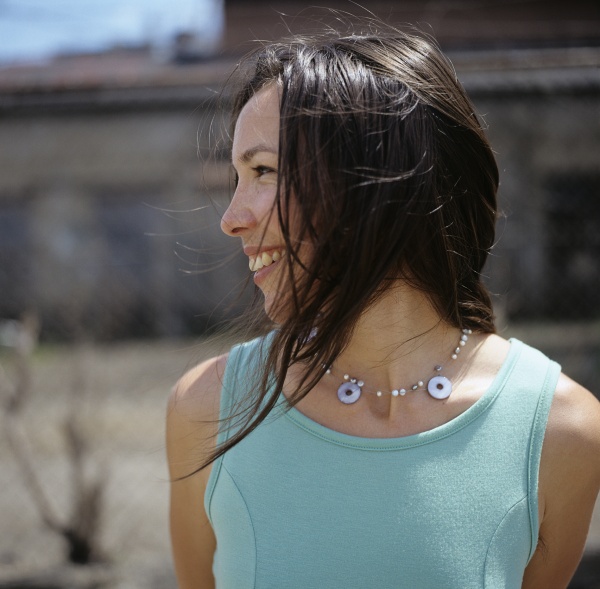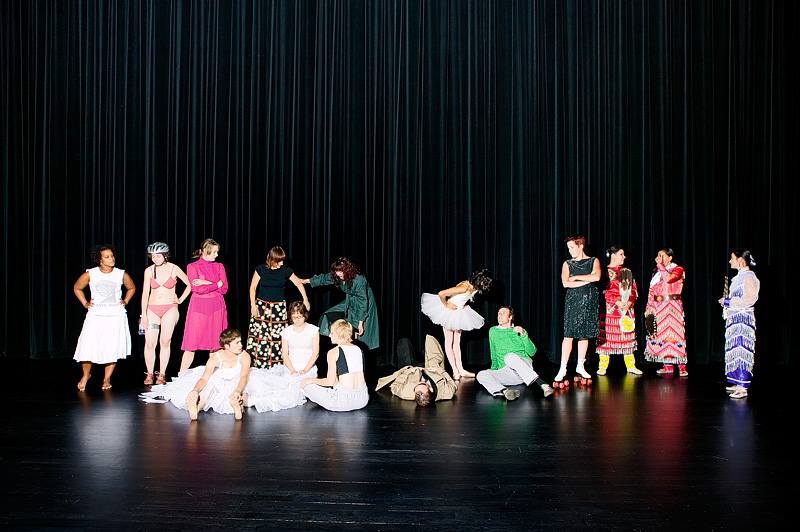Choreographers’ Evening, from Nine Different Angles
Dance critic Lightsey Darst gives a funny, insightful play-by-play dispatch on the sights and chatter surrounding the performances at this year's avant garde dance spectacle, Choreographers' Evening at the Walker.


1. The scene
If it’s the Saturday after Thanksgiving, it must be Choreographers’ Evening, and the Walker must be humming with dance people. Local choreographers have scant opportunities to command the Walker stage, and the venerable Choreographers’ Evening (this was the 35th annual performance) is one of the most exciting: all sorts of dance artists audition before a different local curator each year to participate in this one-night event. Choreographers’ Evening is a great night for viewers too: a chance to see old favorites, find new ones, and check out local trends.
Cut to the ticket lobby: “It’s standing room only,” says a ticket agent, while a woman circulates, covertly handing out little cards (about which more later). And here come the tappers for their pre-show, Ricci Milan and Kaleena Miller in Walker-worthy nude high-heel pumps—my god, can she tap in those things?
Cut to the bar: Pam Plagge is rolling on the floor wearing a gold lamé dress and roller skates. People sitting under Warhol’s mad pink Marilyn crane their necks to see. “Is it over?” “No, she’s starting again.” Do we have time for a martini before the show? Do we have time for two?
Cut to the stage: Anna Marie Shogren is trying to make eye contact with her vague, shifting, still chattering audience. Later, I notice a purple velvet curtain, which I can’t recall ever seeing before. “Oh, you’re here?” “Oh, you’re there.” Thanksgiving already completely forgotten, people are scrabbling through their thickly-written programs, curator Emily Johnson disappearing behind the curtain in a splendidly severe dress: rockstar meets pinstripe dominatrix.
And then the curtain opens.
2. Jump
Okay, so you could say this: “Choreographers’ Evening 2007 opens with a multitude of misfits jumping up and down until they wear themselves out. And that’s choreography in the Twin Cities for you.”
That would be a low blow, but this Choreographers’ Evening does call into question traditional definitions of choreography. Olive Bieringa’s Incandescent (see description above about the jumping misfits) is a score, basically. In at least three other pieces, choreography—if by that we mean the composing and directing of dance steps—is largely absent. Improvisation and tradition rule the evening. So, if we’re going to redefine the term choreographer in accordance with this performance, a choreographer is either a person who creates a score for improvisation—a dramatic/theatrical structure in which more often than not individual movements are up to the performer; or a person who arranges traditional dance elements for presentation. Either way, a choreographer is not a movement inventor, and not really even a movement phrase inventor.
Chris Schlicting’s an exception to this rule. His Example B features two very different performers doing exactly the same movements, in the same sequence. Defined, strict, certain, Example B announces the presence of a single creative mind, where most other pieces exhibit either many separate minds or the mass mind.
3. I didn’t quite catch what you were saying/Heaven is a hard row to hoe
—Not that I mean to endorse Example B above anything else here. I couldn’t make head or tails of it in its limited appearance, sandwiched as it was between disparate works. Example B, Susan Scalf and Dylan Skybrook’s Reducted Objectivity Confession, and Joanna Furnans’s Deference all feel compressed and, at times, impenetrable. Like chunks of longer works, maybe—longer works that we’ll eventually see delivered, I hope. At least Chris Schlicting will have the opportunity to expand on his creation; look for his work in next July’s Momentum series at the Southern.
Along with the avant-garde, Choreographers’ Evening featured several dances that, at heart, aim for the sublime. Tap, Native American jingle dress and fancy shawl dances, and African dance all try to find the sweet spot, the elevation, the blessing zone. But it’s hard to be sublime: “so awe-inspiringly beautiful as to seem almost heavenly” (according to my Microsoft Word dictionary). Any distraction and the glass house shatters. And I have to say I felt distracted. Was it the mixed bill, nervousness in the performers, Kenna Sarge’s over-busy choreography? Perhaps it’s just the nature of a showcase like Choreographers’ Evening: everything’s out of context, glimpsed rather than seen.
4. But!
Lest you think there wasn’t a smash hit at Choreographers’ Evening, let me tell you about Mad King Thomas’s Fish on Bikes: three girls in string bikinis, nerdy bike helmets, and duct taped-on water bottles rush down from the seats, dragging a stationary bike. They take turns peddling furiously to Queen’s “Bicycle Race,” wiggle all over, squirt water on each other, and—
Oh, forget it. You had to be there. Perilously close to porn, in terrible taste, and unforgivably funny, Fish on Bikes bowled everyone over.
5. The Curator: Emily Johnson
Without having seen what she rejected, it’s hard to judge Johnson’s curatorial effort here. What we can judge is her composition of an evening of dance, and she certainly gets a ten in this department: nice mix of big groups and solos or duets, nice mix of styles, nice echoes across the evening. I also must commend her for mentioning the Southern email service and for creating an evening which entertains at the same time that it makes one feel the inadequacy of such tiny bites of each style. Johnson is someone to follow in this dance scene. A former Hot Young Artist (but still quite young and quite hot), she is mid-morph into something more interesting and seems to be busy hacking out a new paradigm of performance. Grandiose? Impossible? Sure, but she’s trying. Keep an eye on her.
6. Give us more
Some things I’m sick of: thrift store t-shirts, the thousand-yard stare, gestures.
Things I’m not sick of: big scale; costume drama; ambition; lemons. Joanna Furnans’s Deference had all four. Though I mentioned above that Furnans’s work felt compressed that night, what a vivid slice it was: Furnan is on a stage littered with lemons, green glass bottles, and white envelopes, wearing a maroon vintage dress, and flashing her two big cocktail rings like a QVC hostess on crack. What a sharp, witty, weird visual, sending out strange vibes in all sorts of directions. Jessica Cressey’s post-show parking garage tableau set off some of the same pleasure receptors: Cressey posed in front of a Spam-tastic party spread on the hood of a two-tone Cadillac de Ville, waving a cigarette holder and sinking her chin into a Cruella fur. These works elevate thrift store “junk” beyond irony and cliché, becoming even tender in their reimagining of past lives.
7. The Missing
With ballet (albeit alt-ballet), tap, African, Native American, avant-garde, and even college modern represented, what went missing? Sincere, emotional, dramatic dance featuring virtuosic technique. Of course it’s hard to see TU Dance or MDT trying out for Choreographers’ Evening, but I don’t think that’s the whole story. “Dancey dance,” as it’s sometimes called, isn’t cool here. With its reputation for showmanship, the performer’s superiority to the audience, elitism, and so forth—dancey dance raises some hackles among the avant-gardists. But lately I’ve noticed some avant-garde choreographers toying with performative dance, most notably Morgan Thorson in her big and lovely Docudrama (April 2007). I hope Thorson’s opened a door others will jeté through.
8. Talk to me
Johnson urged us all to contribute to a post-show discussion on the Walker blogs, and a number of people have taken her up on it. Go over there and check it out: that’s one fiery discussion. We often hear that dance viewers are afraid to wade in and interpret, but there are no shrinking violets among the (admittedly self-selected) respondents. If anything, the responses indicate just how confident a lot of people are in their own judgment (for better or worse).
Remember the woman handing out the cards back at the beginning? She was protesting the exclusion of Jaime Carrera’s Olvidame (in which Carrera appears nude, in high heels and a long wig) from the 7 o’clock “family friendly” performance. Everyone has an opinion on this too, to which I can only add that I’ve seen Olvidame elsewhere and it’s a knock-out—smart, disturbing, and seductive.
9. Curtain
So that’s Choreographers’ Evening for another year. Next year will be more of the same, but entirely different. See you there!
About the writer: Lightsey Darst writes on dance for Mpls/St Paul magazine and is also a poet and editor of mnartists.org’s What Light: This Week’s Poem publication project.
What: Choreographers’ Evening
Where: Walker Art Center, Minneapolis, MN
When: November 24, 2007